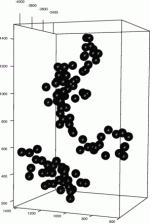Note in space.com.
And here you have the paper published in the Royal Astronomical Society Journal.
This supercluster of 73 quasars (almost doubling the record number so far in large quasar groups) is astonishingly huge, and it broadly challenges the current estimations for large scale homogeneity in the Universe. The cosmological principle seems to need some revision.
The scales in the attached picture are Mpc (mega-parsecs). One Mpc equals approximately 3,62 million light years.
Astronomers have discovered the largest known structure in the universe, a clump of active galactic cores that stretches 4 billion light-years from end to end.
The structure is a large quasar group (LQG), a collection of extremely luminous galactic nuclei powered by supermassive central black holes.
And here you have the paper published in the Royal Astronomical Society Journal.
This supercluster of 73 quasars (almost doubling the record number so far in large quasar groups) is astonishingly huge, and it broadly challenges the current estimations for large scale homogeneity in the Universe. The cosmological principle seems to need some revision.
The scales in the attached picture are Mpc (mega-parsecs). One Mpc equals approximately 3,62 million light years.


